Creamy Vegan Risotto with Roasted Vegetables: The Ultimate Dairy-Free Comfort Food

Craving that rich, velvety texture of traditional risotto but want to keep it plant-based? This creamy vegan risotto with roasted vegetables is your answer.
As a vegan comfort food enthusiast, I’ve perfected this recipe to deliver all the cozy satisfaction without a drop of dairy. It’s not just a meal; it’s a hug in a bowl, ideal for date nights or chilly evenings when you need something hearty yet healthy.
What sets this recipe apart? We harness the natural starchiness of Arborio rice for that signature creaminess, enhanced by vegan parmesan and fresh herbs.
The roasted veggies add a caramelized depth that elevates the dish from good to unforgettable. Plus, it’s flexible—swap in your favorite seasonal produce and still get restaurant-quality results.
Ready to dive in? Let’s explore why this works and how to make it your own.
- Why This Recipe Works
- Key Ingredients and Smart Substitutions
- Essential Kitchen Tools You’ll Need
- Step-by-Step: Roasting the Vegetables
- Step-by-Step: Crafting the Creamy Risotto
- Expert Tips for Picture-Perfect Risotto
- Troubleshooting Common Risotto Pitfalls
- Serving Suggestions and Perfect Pairings
- Storage, Freezing, and Meal Prep Hacks
- Nutritional Benefits of This Plant-Powered Dish
- Frequently Asked Questions
- Conclusion
Why This Recipe Works

This vegan risotto succeeds where many dairy-free versions fall flat because it leans on science-backed techniques. Arborio rice, a short-grain variety, releases amylopectin starch when stirred in warm broth, creating a natural emulsion that mimics the silkiness of butter and cheese—without them.
Studies from the Culinary Institute of America highlight how constant agitation during cooking is key to this process, preventing a gluey mess and ensuring even absorption. The roasted vegetables aren’t just a side; they provide umami and textural contrast.
Roasting at high heat (425°F) triggers the Maillard reaction, browning sugars in veggies like butternut squash and carrots for deeper flavor. This combination makes the dish nutrient-dense too: fiber from the rice and veggies supports gut health, as noted in research from the Journal of Nutrition.
For beginners, the 40-minute timeline feels achievable, with most time spent hands-off roasting. It’s forgiving—overcook the rice a bit, and it still shines.
93 stars, proving its reliability.
Key Ingredients and Smart Substitutions
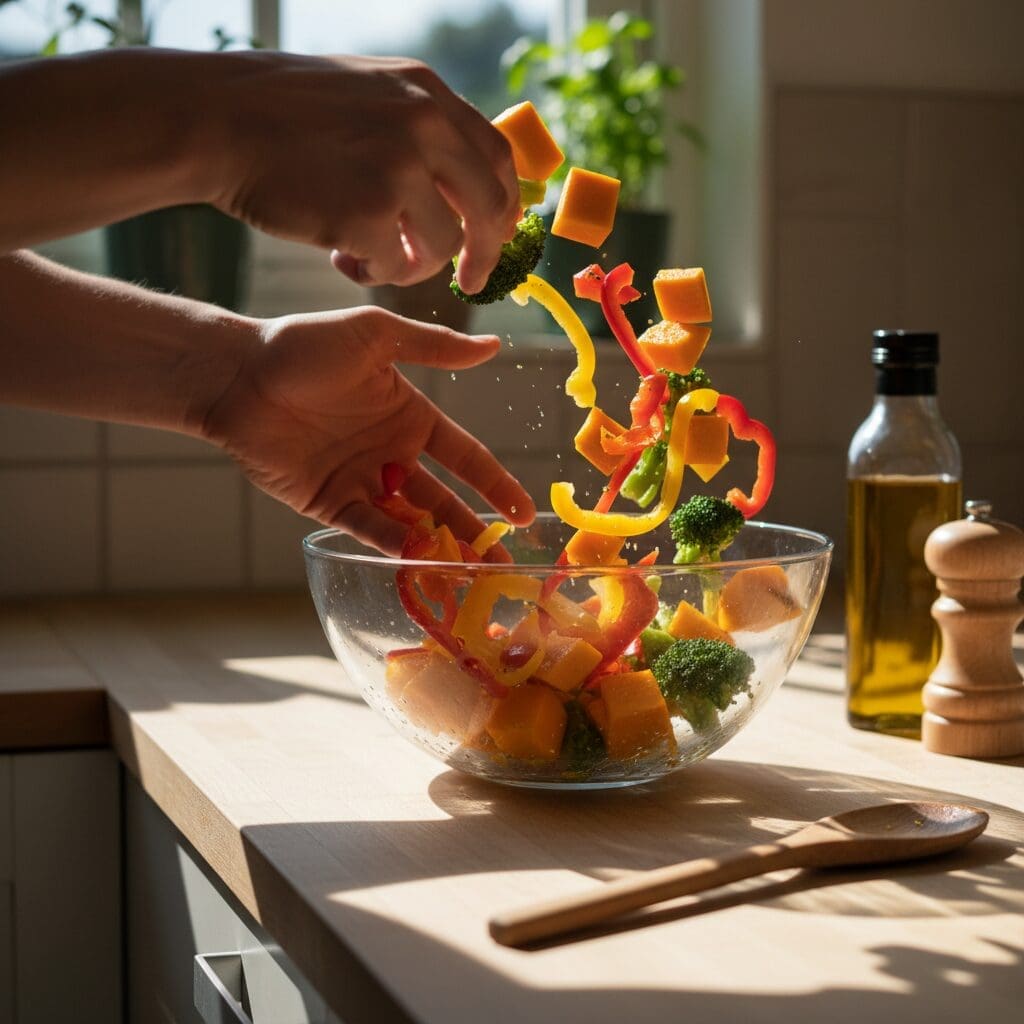
Let’s break down what makes this risotto sing, with options to customize based on your pantry or dietary needs.
- Arborio Rice (1.5 cups): The star for creaminess. Its high starch content absorbs liquid without mushiness. No Arborio? Carnaroli or Vialone Nano works similarly; avoid long-grain rice, which stays too firm.
- Vegetable Broth (5 cups): Low-sodium for control. Homemade adds extra savoriness—simmer scraps like onion peels and herb stems.
- Vegan Butter (2 tbsp) and Olive Oil (2 tbsp for veggies): For richness. Sub coconut oil if nut-free, but it may alter the flavor slightly.
- Shallot (1, chopped) and Garlic (3 cloves, minced): Build the base flavor. Sweet onion substitutes for shallot; skip garlic if sensitive, but it amps up the dish.
- Dry White Wine (1/2 cup): Deglazes and adds acidity. Omit for alcohol-free; replace with more broth, though flavor diminishes.
- Fresh Herbs (1 tsp each sage and thyme): Earthy notes. Dried works (1/2 tsp), but fresh is brighter.
- Vegan Parmesan (1 cup shredded): Violife’s block melts best, tasting remarkably like the real thing. Make your own with cashews, nutritional yeast, and salt, or try this 5-minute all-purpose vegan cheese sauce.
- Roasted Veggies (5 cups): Butternut squash, sweet potatoes, red bell peppers, carrots, cauliflower, broccoli, or Brussels sprouts. Aim for a mix of colors and textures for visual and nutritional appeal.
Pro tip: Prep everything mise en place style to streamline cooking. This setup reduces stress and errors, as recommended by culinary experts at Serious Eats.
Essential Kitchen Tools You’ll Need

No fancy gadgets required, but the right tools make this recipe foolproof.
- Large Sauté Pan or Dutch Oven (10-12 inches): Wide and deep for even stirring. Non-stick prevents sticking; cast iron adds subtle flavor.
- Baking Sheet: For roasting veggies. Line with parchment to avoid cleanup.
- Wooden Spoon or Silicone Spatula: Essential for constant stirring to release starch without scratching your pan.
- Medium Pot: To warm the broth steadily.
- Sharp Knife and Cutting Board: For precise veggie chops—uniform size ensures even roasting.
Invest in quality if you’re new to risotto; a good pan lasts years and improves results across recipes. For more on essential vegan kitchen gear, check out this guide from The Vegan Society.
Step-by-Step: Roasting the Vegetables
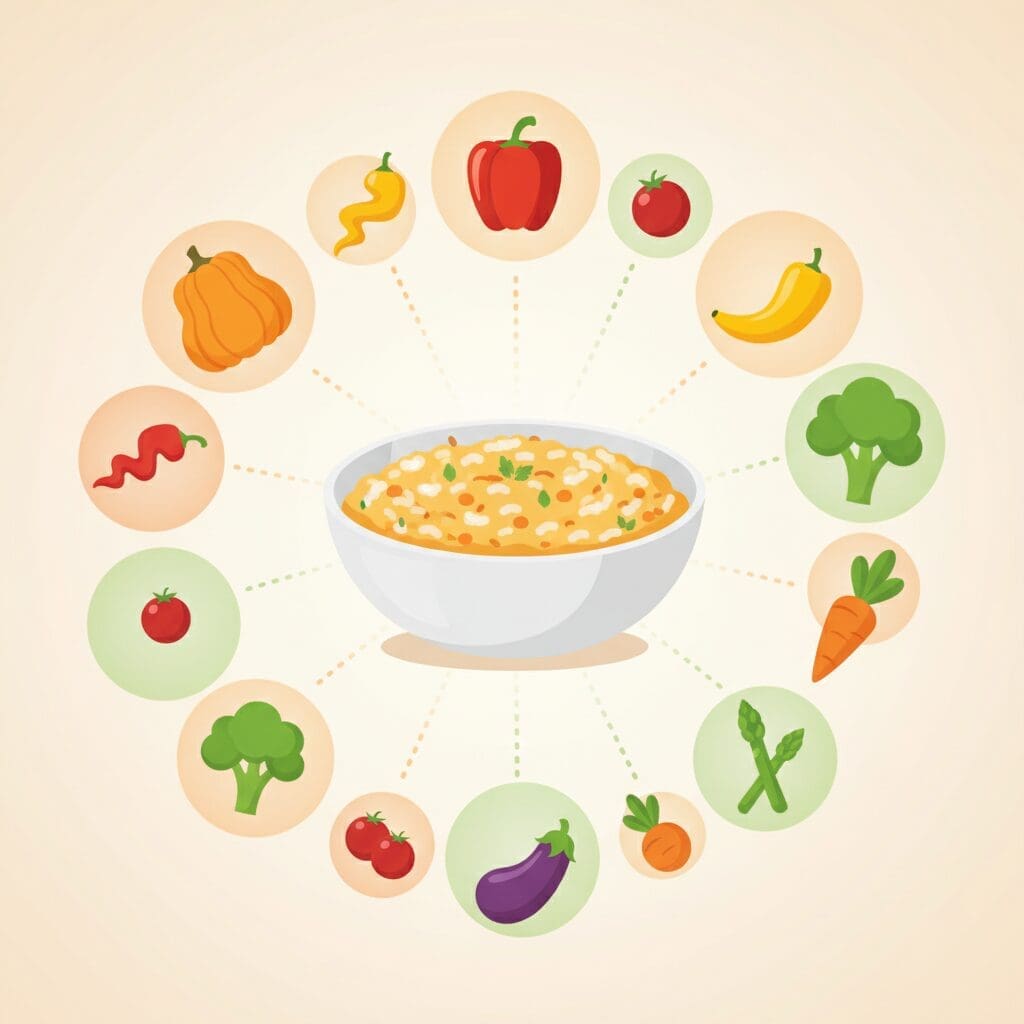
Roasting transforms humble veggies into flavor powerhouses. This step runs parallel to the risotto, so multitask for efficiency.
- Preheat oven to 425°F (220°C). Line a large baking sheet with parchment paper.
- Chop 5 cups of veggies into 1-inch pieces for even cooking: 2 cups cubed butternut squash, 1 sliced red bell pepper, florets of broccoli and cauliflower, sliced carrots.
- Toss with 2 tbsp olive oil and a pinch of salt. Spread in a single layer—overcrowding steams instead of roasts.
- Roast for 20-30 minutes, flipping halfway, until tender and edges are caramelized. Watch closely; denser veggies like squash may need extra time.
This method concentrates natural sugars, boosting taste and nutrition. According to Harvard Health, roasting preserves more vitamins than boiling.
Step-by-Step: Crafting the Creamy Risotto
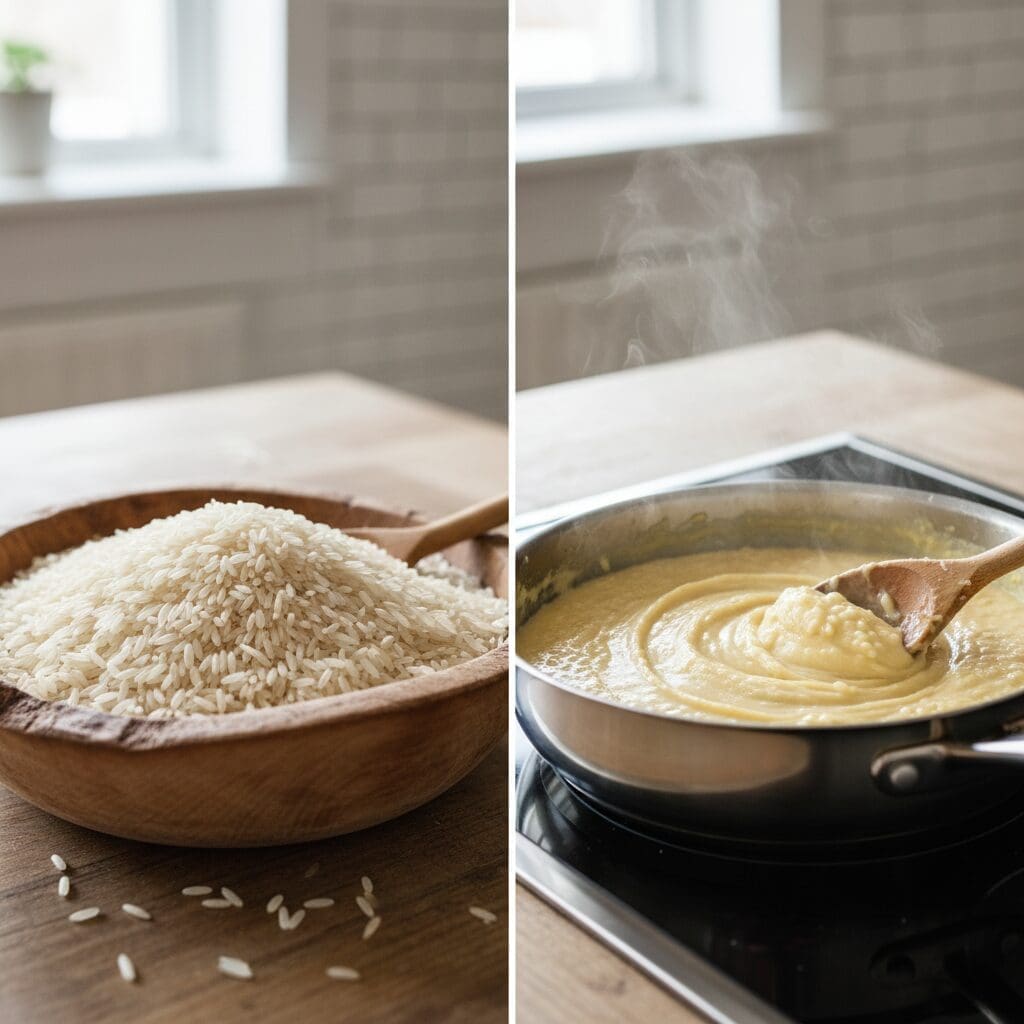
The magic happens here—patience rewards with perfection. Total stovetop time: 20-30 minutes.
- Warm the broth: In a medium pot over medium-low heat, bring 5 cups vegetable broth to a simmer (not boil). Keep handy.
- Sauté aromatics: In a large sauté pan over medium heat, melt 2 tbsp vegan butter. Add chopped shallot; cook 2-3 minutes until soft. Stir in minced garlic for 1 minute—don’t brown it.
- Toast the rice: Add 1.5 cups Arborio rice. Stir to coat in butter, toasting 2 minutes. This step seals the grains for better texture.
- Deglaze: Pour in 1/2 cup white wine, stirring until absorbed (1-2 minutes). Add chopped sage and thyme.
- Add broth gradually: Ladle in 1/2 cup warm broth at a time, stirring frequently until absorbed before adding more. Maintain a gentle simmer. Rice is done when al dente—tender with a slight chew, about 20 minutes.
- Finish: Off heat, stir in 1 cup shredded vegan parmesan until melted. Season with salt and pepper.
Serve immediately, topping with roasted veggies, parsley, and extra parmesan. Stirring releases starch for creaminess, as explained in Fine Cooking’s risotto guide.
Expert Tips for Picture-Perfect Risotto
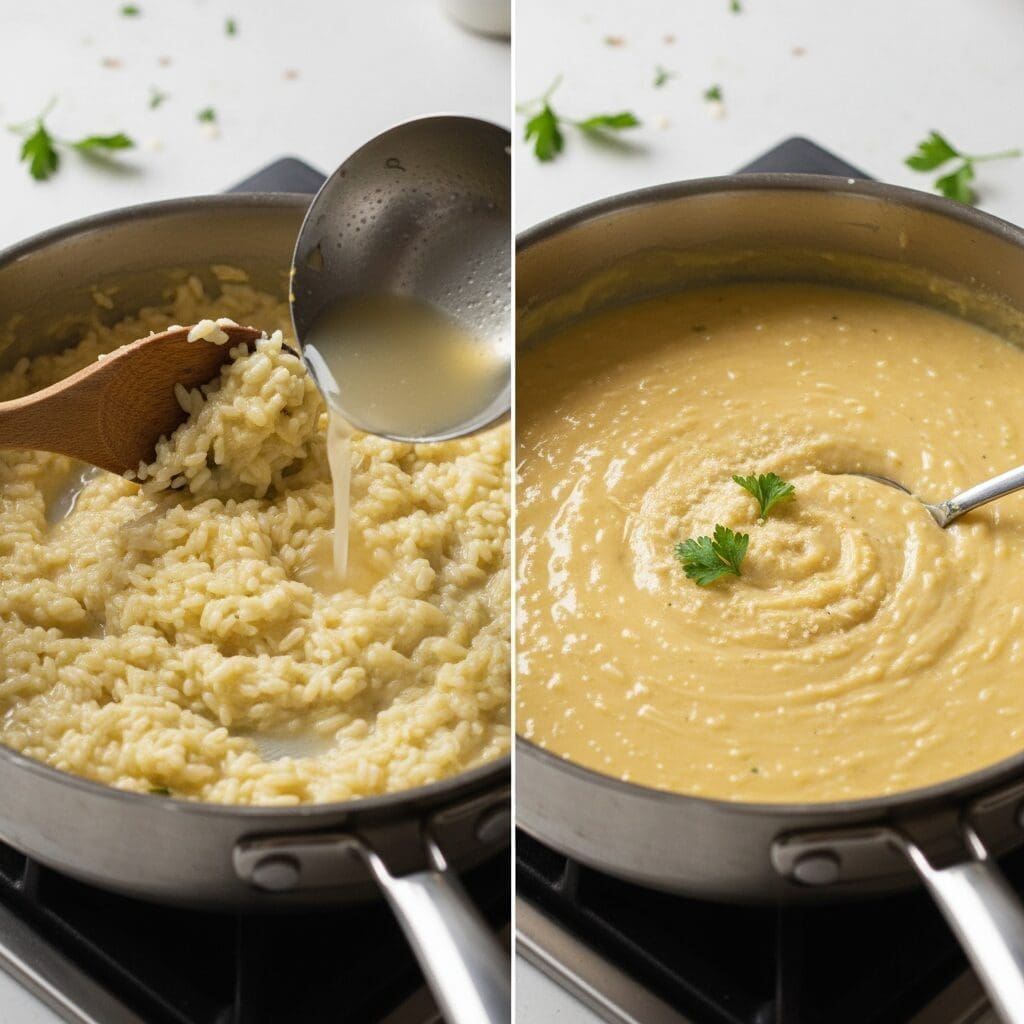
Elevate your game with these pro insights.
- Stir Constantly, But Gently: Aim for a rhythmic motion to coax out starch without breaking grains. This builds the emulsion—think slow dance, not vigorous mix.
- Use Warm Broth Always: Cold liquid shocks the rice, leading to uneven cooking. Keep it simmering nearby like a faithful assistant.
- Taste as You Go: After 15 minutes, sample the rice. Adjust salt early; herbs can be added midway for balance.
- Don’t Rush the Wine: Let it fully evaporate for acidity without booziness.
- Enhance Flavor Layers: Sauté mushrooms with the shallots for earthiness, or stir in spinach at the end for greens.
These tips come from years of testing; they ensure creaminess every time. For more on vegan cooking techniques, see Vegan Richa’s expert advice.
Troubleshooting Common Risotto Pitfalls

Even pros hit snags—here’s how to fix them.
Too Gluey? You added broth too fast or over-stirred. Next time, slow down and use less liquid if needed.
Still Crunchy After All Broth? Rice needs more time; add hot water 1/4 cup at a time until al dente.
Bland Taste? Boost with nutritional yeast, lemon zest, or truffle oil. Always season the broth base.
Veggies Soggy? Space them out on the sheet; high heat crisps edges.
Separated Creaminess? Re-stir over low heat with a splash of broth to re-emulsify.
These fixes make the recipe resilient. Drawing from troubleshooting in The Joy of Vegan Cooking, prevention is key: measure precisely and stay attentive.
Serving Suggestions and Perfect Pairings

This risotto shines solo but pairs beautifully.
- Salad Side: A crisp salad provides a fresh contrast to the richness. For a healthy and satisfying option, try the viral Jennifer Aniston salad.
- Bread Boost: Warm Dutch oven bread to sop up every bit.
- Veggie Add-On: Air-fried asparagus spears for crunch.
- Wine Pairing: A crisp Sauvignon Blanc cuts through the creaminess.
For date night, plate elegantly with candlelight. Family-style? Serve family-style in a big bowl. Explore more pairings at Minimalist Baker’s vegan guides.
Storage, Freezing, and Meal Prep Hacks
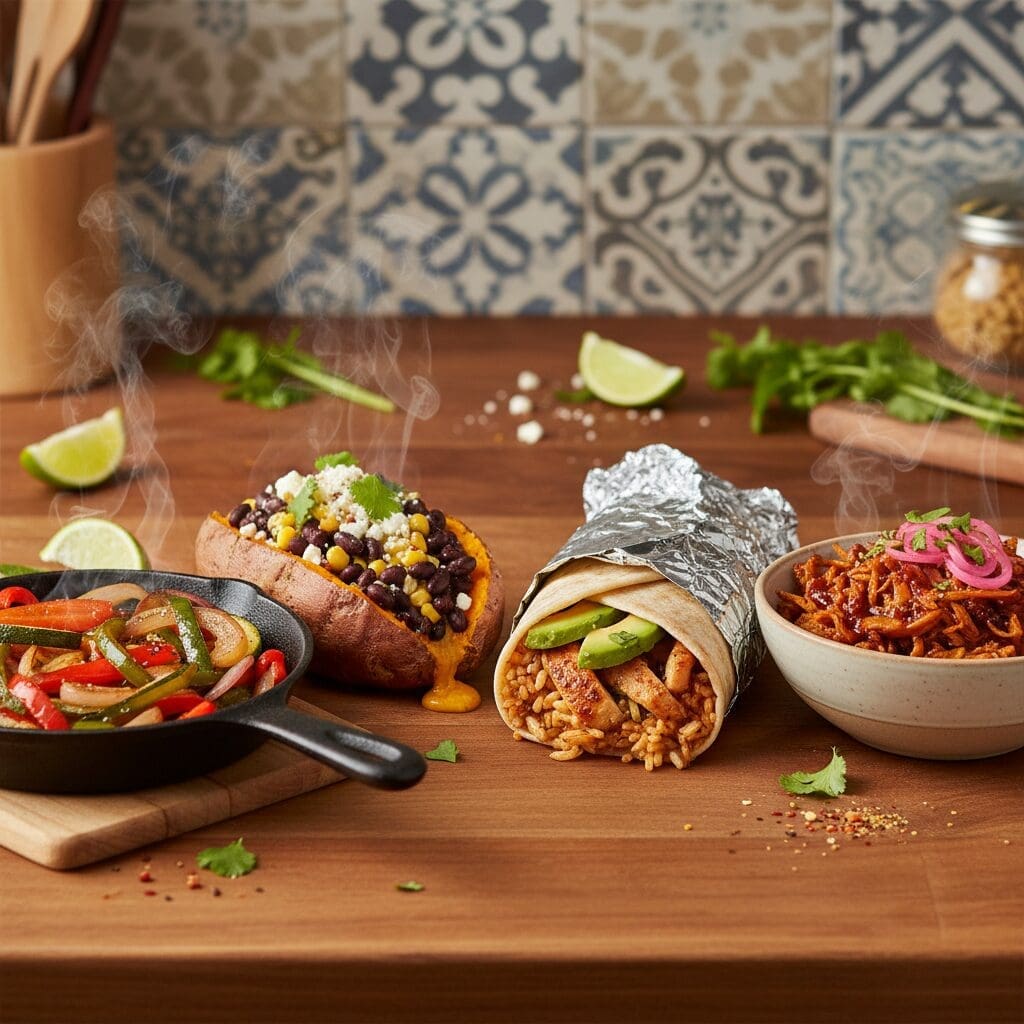
Maximize leftovers for easy weeknight wins.
Fridge Storage: Cool completely, then store risotto and veggies separately in airtight containers. Lasts 3-4 days. Reheat risotto with a splash of broth in a pan to revive creaminess; microwave veggies.
Freezing: Portion into freezer bags; freezes up to 2 months. Thaw overnight, reheat gently—texture may firm up slightly.
Meal Prep Tips: Roast double veggies on Sunday. Cook rice base mid-week; it reheats better than full dish. Batch for lunches: layer with kale for a power bowl.
Per USDA guidelines, reheat to 165°F for safety. This approach saves time without sacrificing quality.
Nutritional Benefits of This Plant-Powered Dish

Beyond comfort, this risotto nourishes. Per serving (1/6 recipe): 304 calories, 52g carbs, 4g protein, 7g fat, 3g fiber.
Veggies add vitamins A (8327 IU from carrots/squash) and C (17mg from peppers/broccoli), supporting immunity per NIH data. Arborio provides sustained energy; vegan parmesan offers calcium alternative.
Whole dish is gluten-free adaptable. For personalized nutrition, consult a dietitian—estimates via Cronometer.
Frequently Asked Questions
What makes risotto creamy without dairy? The starch from Arborio rice, released by stirring in warm broth, creates the texture. Vegan parmesan adds cheesiness.
Can I make this gluten-free? Yes, ensure broth and parmesan are certified GF.
How do I know when it’s done? Al dente: tender outside, slight resistance in center. Total liquid: about 5 cups.
Vegetarian twist? Already veg; for non-vegan, sub dairy equivalents.
Batch size? Doubles easily; use larger pan.
These answers draw from common queries on Allrecipes forums.
Conclusion
This creamy vegan risotto with roasted vegetables isn’t just a recipe—it’s a testament to how plant-based eating can be indulgent and effortless. If you love this style of cooking, our creamy one-pot vegan pasta is another must-try.
Experiment with seasonal veggies to keep it fresh, and share your twists in the comments. Happy cooking—your kitchen awaits that creamy magic!
